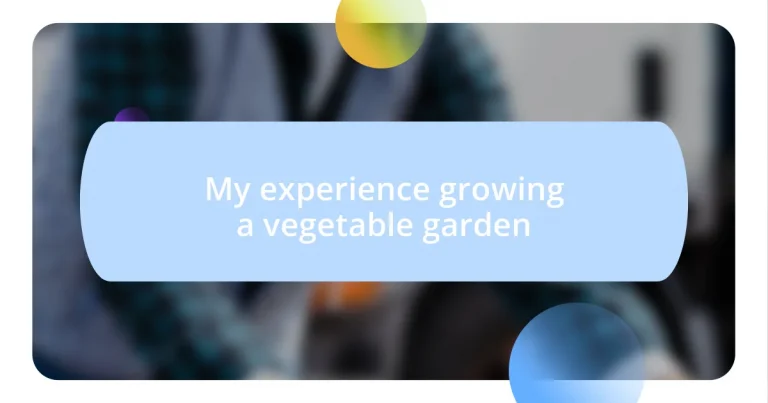Key takeaways:
- Planning a vegetable garden involves understanding growing conditions, creating a layout, and setting a timeline for planting and harvesting.
- Selecting suitable vegetable varieties is crucial; consider climate, space, growth time, and personal preferences to enhance satisfaction and productivity.
- Effective gardening practices include proper watering techniques, pest management, and understanding optimal harvesting and storage methods for produce longevity.

Planning for a vegetable garden
When I first considered starting a vegetable garden, I was overwhelmed by the options available. I remember standing in the seed aisle, feeling both excited and confused—what was the best choice for my small space? This moment made me realize that planning is the cornerstone of a successful garden. It’s not just about picking seeds; it’s about understanding my growing conditions, such as sunlight and soil quality.
As I sketched out my garden layout, I found it crucial to think about both aesthetics and practicality. I visualized how my plants would not only thrive but also how they would look together. Each decision felt personal, from the vibrant reds of tomatoes to the deep greens of leafy greens. Have you ever thought about how a garden could also serve as a peaceful retreat?
Setting a timeline was another pivotal planning step. I marked when seeds needed to be planted and when to expect my first harvest. This process was like mapping out a little adventure. I still recall the thrill of watching my first sprouts break through the soil, a triumphant moment that made all the planning worth it. It’s extraordinary how taking the time to plan can enhance the gardening experience!

Choosing the right location
When I began my gardening journey, finding the right location felt like a puzzle that needed solving. I wandered through my yard, taking note of sunlight patterns and wind exposure. I discovered that a sunny spot, ideally with at least six hours of direct sunlight, was crucial for the vibrant growth of my veggies. I remember marking potential spots with stakes, imagining where my future plants would bask in the sun. Can you picture the joy of watching tomatoes ripen in the late summer sun?
As I explored different locations, I also considered practicality. Proximity to a water source turned out to be vital for easy maintenance. I chose a spot near the garden hose, which made watering less of a chore. Each time I turned on the tap, I could feel the excitement bubbling within me, knowing my plants received the love they needed to thrive. It’s remarkable how a little foresight can yield a lush garden!
Lastly, I learned to observe the soil quality in each potential garden area. I took the time to dig a few patches and noticed differences in texture and drainage. That initial digging was like uncovering a world beneath the surface. The sandy soil in one area drained well, while another patch felt heavy and compact. Selecting the right spot based on these observations transformed my garden into a flourishing oasis. Have you ever considered how essential the soil is for your gardening success?
| Location Factor | Importance |
|---|---|
| Sunlight | Vegetables need at least 6 hours of sunlight for optimal growth |
| Water Access | Proximity to a water source makes maintenance easier |
| Soil Quality | Good drainage and texture can enhance plant health |

Selecting suitable vegetable varieties
Selecting the right vegetable varieties was one of the most fulfilling and challenging parts of my gardening experience. Initially, I felt like a kid in a candy store—so many options! I vividly remember the moment I decided to focus on varieties that would thrive in my specific climate. I chose tomatoes, zucchini, and bell peppers because they not only grow well where I live, but they also filled my plates with vibrant colors and flavors. This choice brought me immense satisfaction, each harvest reminding me of the joy of growing something from seed to plate.
When selecting varieties, I found it helpful to consider a few key aspects:
- Climate Adaptability: Choose varieties that suit your local climate and hardiness zone.
- Space Requirements: Consider how much room each plant needs; compact varieties can be great for smaller gardens.
- Growth Time: Select early and late-season crops to maximize your harvest over the growing season.
- Personal Preference: Opt for vegetables that you and your family enjoy eating—they’ll make all the effort feel worthwhile!
This thoughtful approach made my shopping experience at the nursery not just about choosing seeds, but creating a connection to what I would eventually enjoy on my dinner table. Each packet felt like a promise of future flavors, and that anticipation fueled my excitement as I headed home, ready to plant my chosen bounty.

Preparing the soil for planting
Preparing the soil for planting is a crucial step that I learned is as fulfilling as it is essential. The first thing I did was test the soil in my chosen spot using a simple home kit, which was an eye-opener. The instant feedback showed me the pH level and nutrient composition, allowing me to tailor my soil amendments. It felt almost magical to think about how these adjustments could create the nurturing environment my plants needed. Have you ever sensed the potential hidden within the soil?
Once I understood my soil’s characteristics, I got to work enriching it. I mixed in compost—a decision that radically transformed it! The earthy smell and rich texture of the compost felt satisfying as I turned it into the ground. I couldn’t believe how quickly the soil began to change; it went from being dry and compact to dark and crumbly. This was genuinely rewarding. Isn’t it remarkable how a little patience and effort can lead to such a significant difference?
To ensure proper drainage and soil aeration, I also incorporated some coarse sand and perlite. I remember watching the tiny particles blend with the soil and picturing the roots of my future plants thriving in the improved conditions. I felt empowered knowing that I was laying a solid foundation for what was to come. Isn’t it fascinating how the right soil preparation can set the stage for a bountiful harvest? With this groundwork, I felt ready to dive into planting with confidence.

Effective watering techniques
Effective watering techniques are critical to having a healthy vegetable garden, something I learned early on. I quickly realized that deep watering was much better than light, frequent watering. I started using a soaker hose to allow water to seep directly into the soil, ensuring the roots got the hydration they needed. Honestly, it felt like a gentle hug for my plants, nurturing them without overwhelming them.
One thing that truly transformed my approach was the timing of watering. I discovered that watering in the early morning or late afternoon minimized evaporation— a game changer! I remember rushing outside at dawn, coffee in hand, just soaking in the quiet of my garden while giving my plants their drink before the sun rose high. There’s something incredibly peaceful about those moments, isn’t there? Plus, I found that it also kept my plants from getting stressed in the heat of the day.
Lastly, I learned the importance of observing my plants. When I paid close attention, I could almost hear them asking for water— drooping leaves were a clear sign! I remember a particularly hot week where my zucchini plants looked a bit tired, so I adjusted my routine and provided them with an extra drink. The change was immediate; they perked up, and my heart swelled with relief. Isn’t it amazing how a little attention can make such a difference in the growth and vitality of your garden?

Managing pests and diseases
Managing pests and diseases in the garden can feel like a daunting challenge, but I found it to be a fascinating part of the growing experience. One summer, I noticed small holes in my lettuce leaves that seemed to appear overnight. At first, I panicked, thinking I must be doing something wrong. But when I took a closer look, I realized I was dealing with aphids. I decided to tackle the problem with a homemade soap spray. It was empowering to create my own solution and see my plants thriving again!
Another memorable moment was when my tomato plants became the target of blight. I felt the frustration wash over me, wondering if all my efforts were in vain. Then, I remembered reading about crop rotation and the importance of proper spacing for air circulation. I decided to rearrange my plants and remove the affected ones promptly. It was a tough decision, but staying proactive paid off. My remaining tomatoes flourished, and I learned that sometimes challenges can lead to valuable lessons in garden management.
Additionally, I cherished my birds as natural pest controllers. I made a point to attract them to my garden by placing bird feeders nearby. Watching the birds swoop down to snack on pesky insects filled me with a sense of harmony—after all, it felt like we were working together in this intricate dance of nature! Have you tried attracting wildlife to your garden? It’s a simple yet effective way to reduce pests and create a vibrant ecosystem right in your backyard. Embracing these strategies helped me cultivate a garden that was not just healthy, but also deeply satisfying.

Harvesting and storing your produce
Harvesting your produce is a moment that can feel incredibly rewarding. I still remember the first time I plucked a ripe tomato off the vine—it was such a rush of excitement! There’s something special about seeing the fruits of your labor, right? To make the most of it, I always check for optimal ripeness, which varies by vegetable, but the general rule of thumb is to pick them when they’re vibrant in color and slightly firm to the touch.
After the thrill of harvesting, I quickly learned how vital proper storage is. For instance, I used to throw my vegetables into the fridge without a second thought, but I soon realized that some do better in a cool, dark place. Onions and potatoes thrive in a pantry, while leafy greens feel happiest in a crisper drawer, wrapped in a damp cloth. This little adjustment not only just improved their longevity but also maintained their tasty freshness. Have you ever tasted a straight-off-the-vine vegetable? The difference is remarkable!
Moreover, I discovered the art of preserving my harvest, which added yet another layer of joy to my gardening experience. One summer, I found myself with an abundance of green beans, so I decided to try canning them. The process felt a bit intimidating at first, but when I tasted those preserved beans in the winter, it was like a delicious taste of summer. The nostalgia that flooded through me was unbeatable! Have you explored ways to enjoy the fruits of your labor long after the growing season? It’s an adventure in itself!














